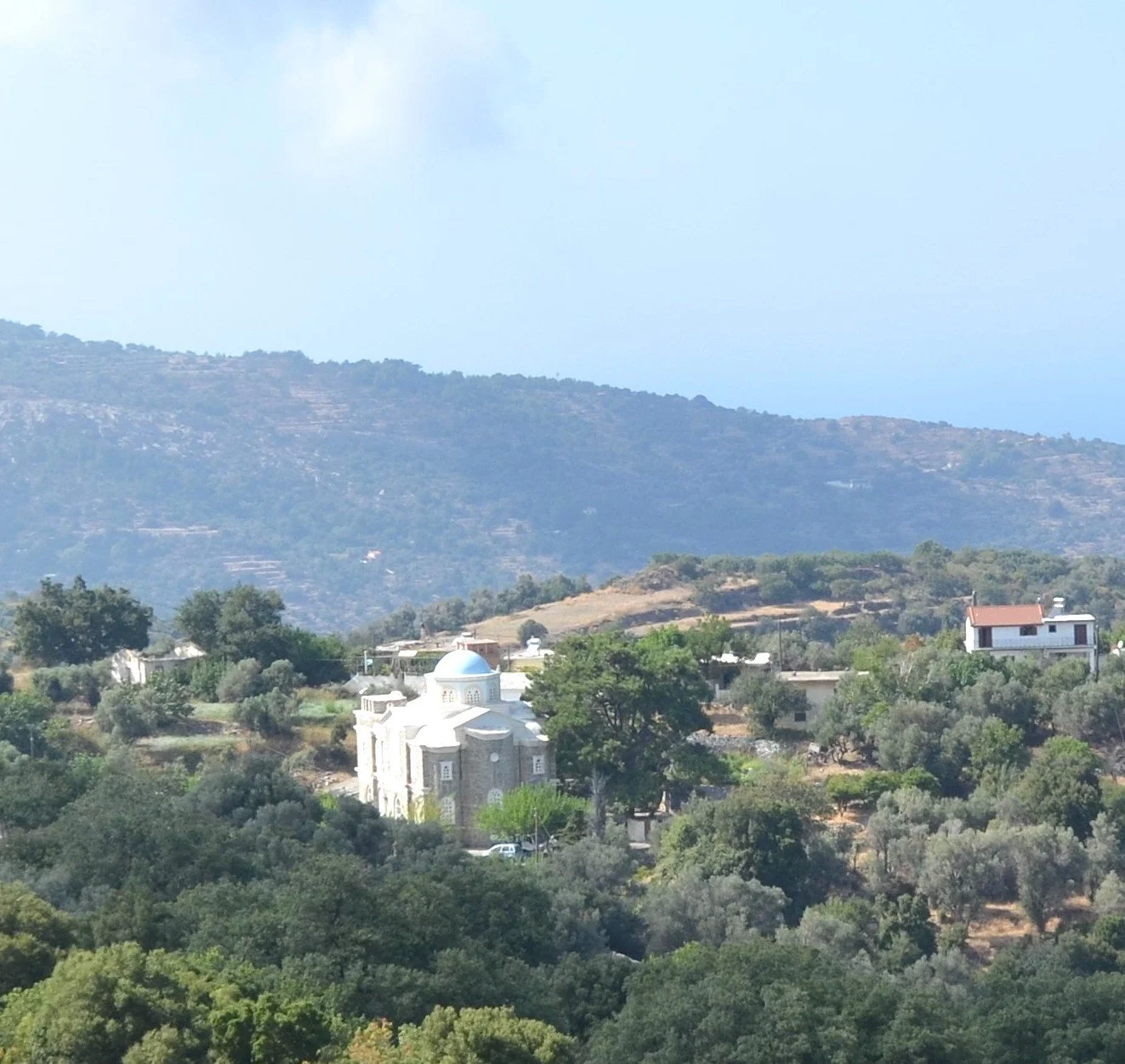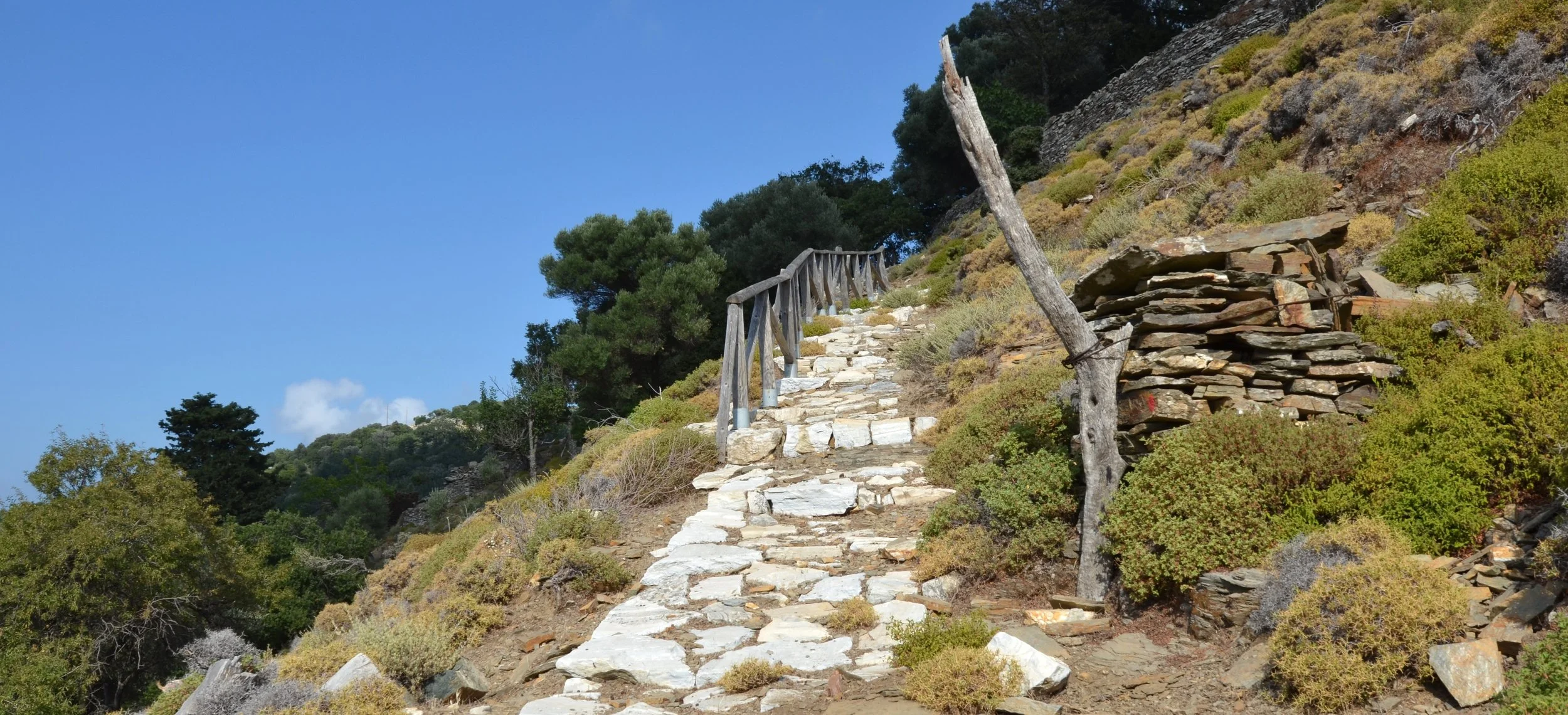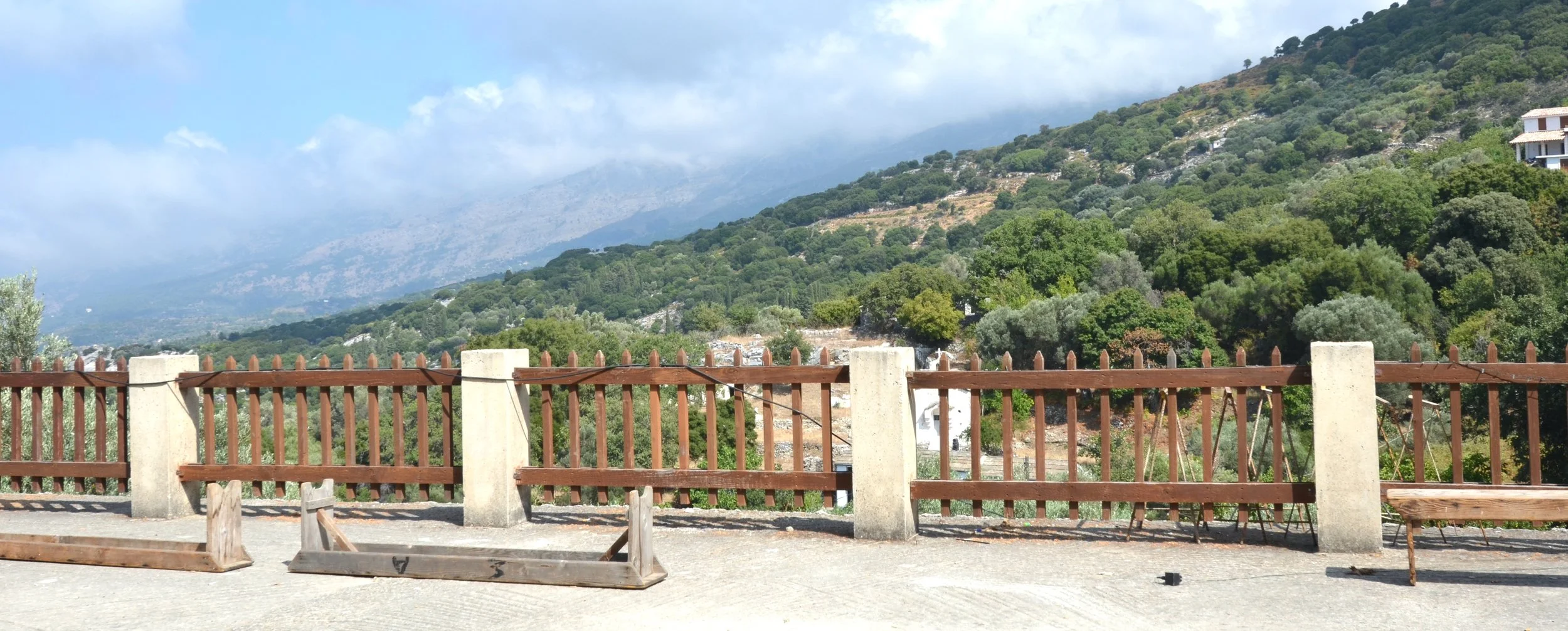Ikaria offers two kinds of experiences. One is the tourist scene: the busy beaches, bustling restaurants and hotels. The other is quieter and more elusive: a deeper immersion into the island’s unique rhythms, shaped by a farmer’s tracks, the nature of mountains, the sea, and a collective sense of remoteness.
The first type of experience is easy to find. The second requires a different approach— and for this you’ll probably want to read my travel notes below:
Early Mornings on Ikaria
A lot of what’s special on Ikaria happens before 9 a.m. In summer I usually wake up around 6 a.m., take a small backpack—water, fruit, snacks, the Ikaria Guidebook—and set off with a friend on a morning short hike. Such hikes (detailed in the Ikaria Guidebook) often begin in a village square, such as Akamatra, Gialiskari, Faros, or Amalou. We set out in the cool light of dawn. Oleander pinks, lemon yellows, and peachy hues are awakening the mountain slopes at this hour. Goats are up, alert and curious about visitors. Birds and Ikaria’s honey bees are chirping and buzzing, diligently working.
One of the best areas I’ve explored on a morning walk is Amalou village. A few minutes up from the main road, a trail path on the hillside reveals a network of hidden secondary village roads and scattered stone homes. This area was an anti-pirate settlement centuries ago. Now, local farmers carry out their chores almost in secrecy. Old stone ‘calderimi’ paths sink into the earth and pop up across slopes. It’s here in Amalou that Ikaria’s unique history begins to make sense to me — here that the island’s strength and resilience chugs along to its own modest pace.
The slate-roofed church in the village square shines with Amalou’s understated local pride, and so does its bakery that is spacious and full of fresh cookies, tiropita and other delicious breakfast goods.
A similar atmosphere can be found in other village areas, like Chrisostomos, where ruins of ‘anti-pirate’ stone houses blend into the mysterious landscape, or around Gialiskari and Raches, where old watermills showcase how Ikarians utilized their rivers. (See the Ikaria Guidebook for exploring these paths.)
Amalou Welcome Sign
If my morning hike is short, I’ll go to the seaside for a swim afterwards. The morning hours are ideal for swimming, especially at Livadi Beach, Skepsis Beach, or the shoreline stretch near Faros Beach leading to Drakano Tower. The southern sea is often calmer. And the sea is different in the morning: cooler, lighter, shimmering like a glass steel blue. This is when locals prefer to swim: when the sun isn’t yet burning.
There is the popular saying that time stands still on Ikaria. But actually, it doesn’t. The sun marks the passing of each precious moment — its opening rays, its morphing intensity, its intense blindness, and then, its long and reflective retreat. Ikarians shape their routines around the sun’s relentless, yet invigorating daily schedule.
Lunch and the Afternoon
Around noontime I’ll look to eat something small and simple. Sourdough bread from a local bakery, olives, some cheese, maybe a big juicy tomato. Visiting Ikaria’s small grocery stores can tell you more about the culture —how people greet each other, what they buy, and what’s in season. In Raches, there's a grocery store on the hill before the village square that still keeps to the island’s local ways.
For a budget-friendly lunch, I also like to stop in Gialiskari for a grilled souvlaki that costs about five euros. This is also a perfect place to sit outside and observe both people and the early flow of open-back trucks making deliveries toward Armenistis.
Afternoons are usually hot in summer. I visit places that offer shade—Theoktistis Monastery, small churches, and archeological and folk museums. Ikaria’s history is profoundly powerful. A small modest chapel might have served as a resting point for Ikarians traversing their island by footpath. The church in Kampos village rests on the remnants of an ancient temple. Even without much explanation, you can soon sense Ikaria’s hidden layers and its exuberant, Dionysian spirit.
When the sun intensifies, I also try to rest a bit. This is mostly to preserve my energy for the night. Traditionally, Ikarians sleep in the afternoon and then wake up again to stay up very late. Once you adapt to this daily pattern on the island, you’ll feel how it energizes both the body and the mind.
Early Evening Walks
After a nap and if the day has cooled off to safe walking temperatures, I might do another walk with a hiking friend. One of the most meaningful walks I’ve found slinks down through a valley from Akamatra and up to Droutsoulas. You pass heroic hideouts on this path, and get a feel for Ikaria’s history of resistance and rebellion —stone fragments, clusters from a ruined village, a refuge cave where resistance fighters once hid, water conduits, and plenty of mesmerizing views. (In the Ikaria Guidebook we provide an outline of this walk and its historical importance.) You come to understand Ikaria more fully as this path unfolds around you and all of your senses.
Stone steps leading up to Droutsoulas Village
Music and the Golden Hour of Sunset
In the evening, I try to look for live music at a restaurant. Ikaria’s musicians have a way of pulling you deeper into the island’s energy. Equally awesome are the sunsets at Nas — which I don’t photograph. Rather, I try to absorb them into my mind’s special chest of memories. I also like to imagine an ancient flotilla of boats passing before the Temple of Artemis, praying for safe passage along Ikaria’s rocky shores.
Eating Well and Contributing to Ikaria
The evening hours are of course for eating and table conversations. Ikarians are proud about their island dishes; you will not be disappointed. Many places, like ‘Plaka’ above Arethousa, or Filoti’s Pizza (which serves so much more than pizza) in Agios Kyrikos are local favorites. And you can keep to a budget — it’s the vegetables, the cheeses, legumes, herbs, tzatziki, bread and the wines that present the real tastes of the island.
I try to visit a different restaurant each night, or head to a summer festival: panigyri. The crowds can be overwhelming at these, but the experience is unworldly. You dance with strangers, fall in sync to the sounds of a wailing violin, and often link arm and arm with locals. The money spent on food and wine at panigyria support the particular village hosting the event. On Ikaria, where self-reliance shapes its infrastructure, this support really matters.
Night in the Mountains
Some of my favorite Ikarian nights are in the mountains. There are guesthouses that offer simplistic close-to-nature stays and expansive views. Waking up in the mountains, with the island’s roosters and birds, always feels refreshing and grounding. At night, total blackness takes over and the stars shine with all their ancient constellations. True night also possesses a unique, healing attribute. On a night walk, when immersed in total blackness, a nocturnal awareness washes over me. An awareness that invites a harmony of the senses, connectivity with the universe, and a comforting feeling of peace.
Overlook area in Akamatra Village
Popular Activities
There are many options for activities on Ikaria now, and some undoubtedly cater mostly to tourists. However, they can still offer exciting views into what makes this island tick. When I splurge, I like to do some of the following:
I do a yoga class at The EGG. The location of this local retreat center, overlooking the sea, is beyond stunning.
I take a tour of a winery, as the local vineyards are closely woven into the island’s history, land and culture. Also, the locations of these wineries are all sublime.
I seek out an adventure at Ikaria Diving Center or at Ikaria Surf School to learn more about Ikaria’s marine life and have fun in the water!
If you follow even part of this kind of loose itinerary—walks at dawn and late afternoon, swims before noon, afternoon naps, late dinners in local places, local music and dancing, nights under the stars—you’ll begin to understand why Ikaria is the way that it is and why you’ll probably want to go back very soon.
To experience the walks mentioned in this blog post, see the Ikaria Guidebook.
For more itinerary ideas to plan your visit, please visit our Trip Planner
Thank you and happy travels to Ikaria!
—————
Charlene Caprio / The Ikaria Guidebook










